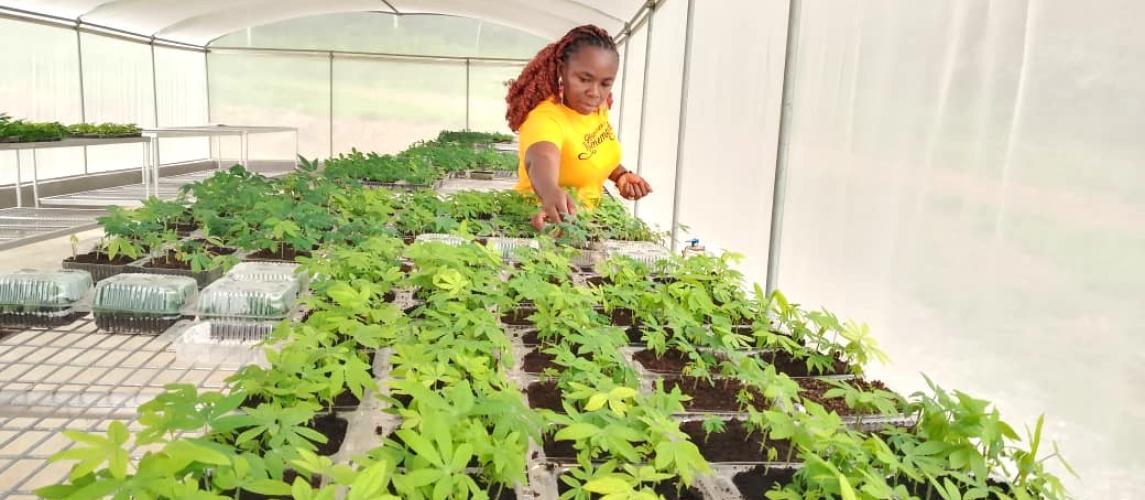
CARI Root & Tuber Unit Subcultures 5,520 Cassava Plantlets Using SAH Technology To Boost Disease-Resistant Varieties
Suakoko, Bong County – The Root and Tuber Unit under the Crop Program at the Central Agricultural Research Institute (CARI) has successfully subcultured 5,520 cassava plantlets using Semi-Autotrophic Hydroponics (SAH) technology. This innovative method is being deployed to accelerate the multiplication of disease-resistant and high-yielding cassava varieties for farmers across Liberia.
Of the total plantlets, 1,021 have already been transplanted into field plots at the CARI station, marking a significant milestone in scaling up production and delivering tangible benefits to farming communities.
Mercy Kou Lah, Extensionist and Head of the Root and Tuber Unit, described the initiative as a turning point in cassava production in Liberia. She noted that in June 2025, CARI, in collaboration with the International Institute for Tropical Agriculture (IITA), officially launched the SAH technology at its headquarters in Suakoko, Bong County. This advancement represents a major leap forward in agricultural development, particularly in the propagation of improved cassava varieties.
SAH is a cutting-edge propagation technique that enables rapid multiplication of cassava plantlets in a controlled environment. Its benefits include accelerated multiplication rates, reduced water usage, enhanced plant health, and uniform growth for consistent yield and quality.
The introduction of SAH has garnered interest from agricultural stakeholders, researchers, and media outlets. Outreach efforts have included farmer and technician training sessions, live demonstrations, media coverage showcasing SAH’s potential through one-node cutting techniques, community engagement promoting disease-resistant varieties, and collaborative research to ensure long-term sustainability.
Ms. Lah described the Root and Tuber Unit as one of the most dynamic and productive divisions within CARI’s Crop Program. With a mission to improve the cultivation and productivity of root and tuber crops, the unit plays a vital role in promoting sustainable food systems and increasing income generation for rural communities.
Currently, the unit is conducting adaptive research on cassava and sweet potatoes, while also prioritizing crops such as yams, ginger, turmeric, and cocoyams (eddoes). Its strategic focus includes developing new cultivars with higher yields, enhancing resilience to climate change, improving resistance to pests and diseases, and ensuring superior quality for processing and end-user applications.
This report highlights key achievements and milestones realized by the Root and Tuber Unit from January to October 2025. As a staple crop in Liberia, cassava holds immense potential to improve national food security, increase farmer incomes, reduce dependence on imported food, and strengthen climate resilience in agriculture.
In partnership with the Ministry of Agriculture, CARI is spearheading a transformative initiative to cultivate 40 hectares of cassava across its campus. The selected varieties are characterized by high yield and dry matter content, making them ideal for industrial starch production, a critical input for food processing, pharmaceuticals, textiles, and bio-based products.
The objectives focus on strengthening Liberia’s agro-industrial capacity, promoting value addition in cassava farming, creating new income streams for rural communities, and reducing reliance on imported starch products.
As of October 2025, 50% of the targeted 40 hectares have been successfully cultivated. Once fully established and evaluated, the improved cassava varieties will be transferred to organized farmer cooperatives. These cooperatives will lead efforts in scaling up production, managing supply chains, and engaging with markets.
This collaborative approach ensures that research and innovation directly benefit farming communities, empowering them to participate in and profit from CARI’s agricultural advancements.

